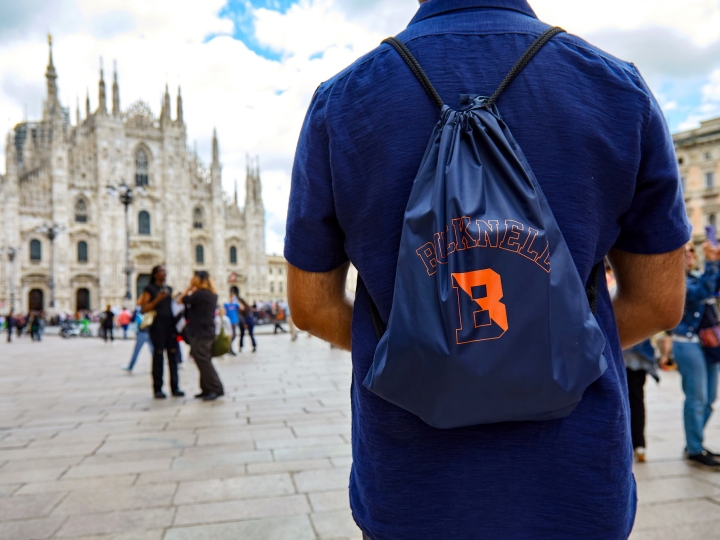
No U-Turns Allowed
May 1, 2014
L to R: Doug Gabauer, Whitney Tatem '15, Eric Kennedy, Sarah Manoogian and Craig Beal. Photography by Bill Cardoni
These Bucknell engineers help keep you safe on the road.
Biomedical engineering major Whitney Tatem '15 was en route to visit family in Rochester, N.Y., last winter when her car hit a patch of black ice on U.S. Route 15 in north-central Pennsylvania. The Chevrolet Impala crashed into the median at 55 mph, spun out and came to a rest facing oncoming traffic.
"It was an absolute miracle that I wasn't injured, but the car was totaled," Tatem says. "I consider myself very lucky."
Her accident was one of the more than 5.3 million vehicle crashes that occur each year on American streets and highways, according to data from the National Highway Traffic Safety Administration (NHTSA). In its most recent statistics, from 2011, NHTSA reports that 32,367 people were killed and 2.2 million drivers and passengers suffered injuries in car crashes. While fatal crashes are down by more than half since 1970, Bucknell faculty and student researchers, including Tatem, are doing work that could lead to new understandings and potentially revolutionary innovations in auto safety.
"A lot of basic vehicle dynamics are known, so the projects that are happening now are looking more fully at the environment around the car," says Craig Beal, a professor of mechanical engineering. "We're tying things more closely to the whole picture of driving, not just to the dynamics of a vehicle on the road."
Beal, who teaches a course in vehicle dynamics and controls, is developing a system to let motorists know about a range of possible dangers, like black ice, by monitoring sensor data from the car. (Most cars now under production are equipped with sensors). The friction coefficient, for example, represents the changes in grip that tires exert on the road due to weather and other factors.
Road surface data could be gathered from cars, which would relay information to roadside "base stations." Findings, in turn, might be transmitted to oncoming traffic in the form of warnings in windshield graphics — a program Beal calls VIVID (Vehicle to Infrastructure to Vehicle Identification). Information could tell motorists to drop their speed on an approaching curve, for example.
"You're already looking at the road for clues," Beal says. "Is the road curving? Are there obstructions? If you could somehow augment the image that the driver is already processing with their vision, then you might be able to provide extra information in a natural context. The key is to provide the information without significantly changing the driver's mental work load."
Beal is among a quartet of Bucknell engineering faculty members exploring automotive safety by considering, not just onboard technological advances, but also roadside factors and a car occupant's biomechanics and thresholds for injury.
They're building on pioneering work done by the late Richard McGinnis '68, a Bucknell professor of civil and environmental engineering who is credited with bringing wire-rope guardrails to U.S. roadways. McGinnis, who died in 2011, also helped reconfigure and strengthen the common weak-post W-beam guardrail and he aided in the creation of crosswalk warning systems that make streets more pedestrian friendly.
Beal and his students are developing VIVID with a pair of radio-controlled cars and a track on which various road conditions can be simulated. He expects that the vehicles ultimately will be able to transmit a stream of data about the road surface.
For Doug Gabauer, a professor of civil and environmental engineering, automotive safety can't be gauged without determining the crash performance of guardrails and concrete barriers lining roadways. His research considers secondary collisions, in which vehicles strike another object after bouncing off a barrier. He's also researched large truck impacts to real-world roadside barriers. Trucks breached barriers in 17 percent of crashes. Gabauer wrote in 2012, "It's often motorists traveling in the opposite direction that face drastic consequences if the barrier doesn't perform properly." He adds, "My research focuses on the bigger picture painted by real-world crash data and uses that information to guide future safety improvement efforts."
One of Gabauer's students and research collaborators was Randy Gowat '10, M'12, who earned degrees in civil and environmental engineering and is a Washington, D.C.-based technology consultant. In research presented to the Transportation Research Board, Gabauer and Gowat reported that vehicles redirected into traffic by a barrier — as opposed to coming to a stop next to the barrier — are 15 times more likely to experience a second crash.
"The whole goal of roadside barriers is to cradle the car and bring it to a safe stop on the side of the road, to create what is called a forgiving roadside," Gowat says. "Our research was an attempt to make people who publish national guidance a little more aware of what they should be focusing on and what's important in the real world."
Gabauer's class guides students through the "relatively new field" of roadside safety, in which they use the geometric design of roadways and the configuration of the roadside area to predict crash likelihoods at various sites. Students then consider safety interventions that could include re-grading the side of a road or installing guardrails at a particular location.
Tatem also worked with Gabauer on a summer research project, in which she analyzed NHTSA crash data to review mathematic models evaluating the level of risk to car occupants in side-impact crashes. She continues work on the study. "The ultimate goal is to assess how accurate and precise the model is," Tatem says.
Findings could help predict occupant injury without the use of expensive crash test dummies.
Eric Kennedy's research is guided by a different question: What is the human body's threshold for breaking?
Kennedy, a professor of biomedical engineering, began studying both pedestrian accidents and advanced seat cushion-mounted airbag technology in 2004. His findings are being used by Ford, Volkswagen and Audi as the companies consider technologies for protecting the lower body in collisions. Kennedy says the lower extremity is more frequently injured than any other part of the body in crashes.
As car manufacturers contemplate new safety innovations, Kennedy comes at the discussion differently. His research focuses not on the protective benefits of equipment, but asks whether the equipment itself poses safety risks to vehicle occupants. Which raises the question: Is some injury acceptable if it prevents catastrophic injuries or death?
"It's always a debate," Kennedy says. "Air bags early on were actually so powerful that they sometimes caused severe or fatal injuries to small women and children. Additionally, they were causing eye injuries at a higher rate than we were ever seeing in car accidents before."
They've since been "depowered" to cut their risks to occupants and now sensors assess body mass to, if necessary, "choose a less aggressive deployment strategy," Kennedy says. "Most of our safety systems are evolving to that kind of potential."
He's now studying eye injuries for the Army, work he says could be applied to motorcyclists and drivers alike. The same ballistic eyewear that can protect soldiers from shrapnel can also protect motorcycle riders from rocks and debris. Similarly, sunglasses can minimize the shearing forces of an airbag, he adds.
Kennedy has worked with Sarah Manoogian, a professor of mechanical engineering, to create a "drop tower," in which faculty and students can crash car components into a dummy head, known as a "headform." The device, in the shape of a head, is fitted with sensors that can register data. Research has not yet been performed on the apparatus.
Manoogian teaches an accident analysis course and she's particularly interested in car crash impacts on pregnant women and fetuses. Every year, more fetuses die in car crashes than children in child safety seats, but little data exist to pinpoint the reasons for fetal death, Manoogian says. Most federal crash data only specify injuries received by the mother.
"If you think about shaking up an egg, you can break the yolk without breaking the shell," Manoogian says. "The fetus can die or have an adverse outcome even though there's no direct injury to the restrained mother. It's this unrestrained occupant that you have riding in a car, so the question is, how can you protect it?"
She continues to work on the report and she hasn't yet drawn any conclusions. Manoogian says a restraint system designed especially for pregnant women could improve fetus safety in a crash. Safety devices for pregnant women aren't different than those for the general population, she notes. The only guidelines are to wear a seatbelt and sit at least 10 inches from the steering wheel.
"We're protecting a lot of people in car crashes, but there are still special populations for which we don't have enough information to protect," Manoogian says. "We have to pinpoint areas where we should be collecting more data. The injuries that happen to pregnant women may not be directly related to fetal loss, but they can give us a better indication of how to restrain pregnant occupants and hopefully in some way to also restrain the fetus."
For now, driving remains a distinctly human exercise, perhaps best done with two words in mind: Be careful.
"You can tell a driver that the road is slippery and still have them barreling into a corner and there's only so much you can do," Beal says. "Informing people certainly helps, but there are also aspects of risk tolerance, driving styles and decision making that ultimately determine the outcome in safety-critical situations."
Andrew Faught is a freelance writer living in central California. He has written widely on issues and ideas of higher education.

